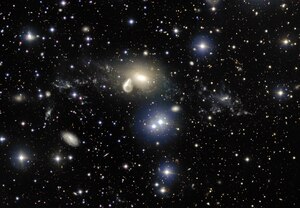NGC 5291
| Galaxie NGC 5291 | |
|---|---|
 | |
| Aufnahme des Very Large Telescope: oberhalb der Bildmitte NGC 5291, unmittelbar links davon «the Seashell» | |
| AladinLite | |
| Sternbild | Zentaur |
| Position Äquinoktium: J2000.0, Epoche: J2000.0 | |
| Rektaszension | 13h 47m 24,5s[1] |
| Deklination | -30° 24′ 25″ [1] |
| Erscheinungsbild | |
| Morphologischer Typ | E pec: poss. LINER [1] |
| Helligkeit (visuell) | 13,9 mag [2] |
| Helligkeit (B-Band) | 14,9 mag [2] |
| Winkelausdehnung | 1,2′ × 0,8′ [2] |
| Positionswinkel | 168° [2] |
| Flächenhelligkeit | 13,9 mag/arcmin² [2] |
| Physikalische Daten | |
| Zugehörigkeit | LGG 357 |
| Rotverschiebung | 0,014602 ± 0,000019 [1] |
| Radialgeschwindigkeit | (4378 ± 6) km/s [1] |
| Hubbledistanz vrad / H0 | (190 ± 13) · 106 Lj (58,2 ± 4,1) Mpc [1] |
| Geschichte | |
| Entdeckung | John Herschel |
| Entdeckungsdatum | 8. Mai 1834 |
| Katalogbezeichnungen | |
| NGC 5291 • PGC 48893 • ESO 445-G030 • MCG -05-33-006 • 2MASX J13472445-3024250 • SGC 134433-3009.5 • GC 3646 • h 3535 • AM 1344-301 • HIPASS J1347-30 • LDCE 0996 NED051 | |
NGC 5291 ist eine rund 190 Millionen Lichtjahre entfernte elliptische Galaxie, die mit einer kleineren, stark verformten Galaxie wechselwirkt, die den Spitznamen «the Seashell» trägt. NGC 5291 liegt im westlichen Außenbereich von Abell 3574 und ist möglicherweise ein Mitglied dieses Galaxienhaufens.
Die Galaxie wurde erstmals von Longmore et al. in einer im Jahr 1979 veröffentlichten Studie eingehender untersucht. Auf sie geht auch der Spitzname «the Seashell» für die interagierende Galaxie zurück, die mit einer großen Geschwindigkeitsdifferenz an NGC 5291 vorbei zu fliegen scheint.[3]
NGC 5291 wurde am 8. Mai 1834 vom britischen Astronomen John Herschel entdeckt.[4]
Weblinks
- ESO: VLT blickt erneut auf eine seltsame kosmische Kollision 9. Dezember 2015
Einzelnachweise
Auf dieser Seite verwendete Medien
Autor/Urheber: Credit: ESO, Lizenz: CC BY 4.0
The surroundings of the interacting galaxy NGC 5291
The spectacular aftermath of a 360 million year old cosmic collision is revealed in great detail in this image from ESO’s Very Large Telescope at the Paranal Observatory. Among the debris surrounding the elliptical galaxy NGC 5291 at the centre is a rare and mysterious young dwarf galaxy, which appears as a bright clump towards the right of the image. This object is providing astronomers with an excellent opportunity to learn more about similar galaxies that are expected to be common in the early Universe, but are normally too faint and distant to be observed by current telescopes.
Credit: ESO
About the Object Name: NGC 5291 Type: • Local Universe : Galaxy : Type : Interacting Constellation: Centaurus Coordinates Position (RA): 13 47 19.40 Position (Dec): -30° 24' 4.50" Field of view: 12.65 x 8.76 arcminutes Orientation: North is 90.0° right of vertical
Colours & filters Band Telescope Optical V Very Large Telescope FORS2 Optical R Very Large Telescope FORS2 Infrared I Very Large Telescope FORS2.



